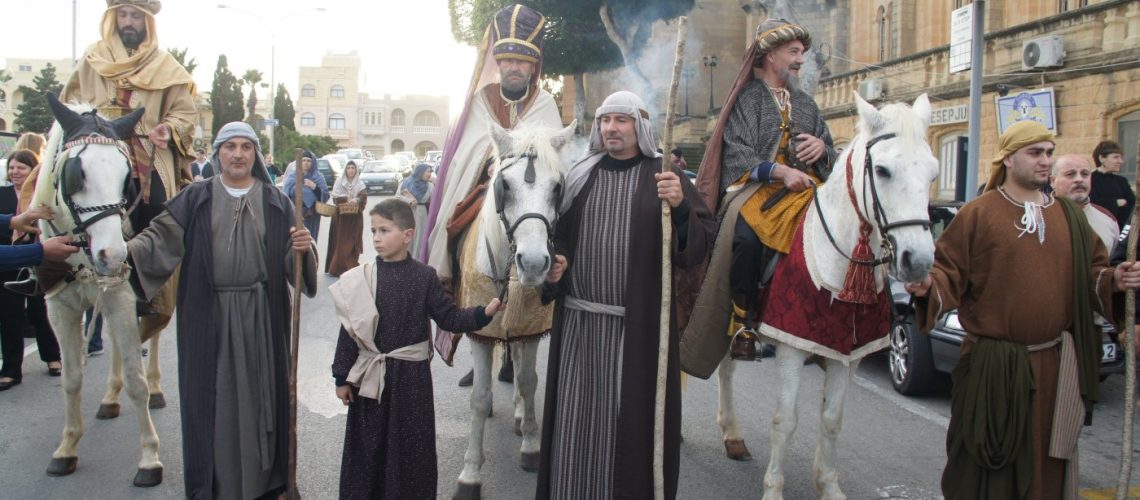Taking the ferry to Gozo from the modern metropolis of Malta is like stepping back in time. Instead of tall tower blocks and bustle, the buildings nestle close to the land, an unassuming stripe along the skyline where traces of the old traditions of the archipelago can still be found.
During December, in the village of Ghajnsielem, visitors can travel yet further back in time, stepping 2000 years into the past to the days when Jesus was born. The name of this village, the first to greet you as you land in the small port of Mgarr and look up to the hillside above, translates as Spring of Peace. Freshwater water bubbled from the ground here in earlier times and flowed down the valley giving life to plants and people. Now during advent, another kind of new life is celebrated with the biggest Christmas crib in Malta. The tranquil landscape of Ta Passi that slopes between Ghajnsielem and the port is transformed into a life-size crib, a Bethlehem village that transports visitors back to The Holy Land.
Cribs and dioramas of the nativity scene are a long-standing tradition here, constructed with incredible craftsmanship as layer after layer of papiér maché are built over a wire skeleton then intricately coloured and embellished. At the centre, a tiny baby Jesus in a manger, Mary and Joseph standing over him, the cows lowing gently by his side. The dusty donkey is at the door; tiny sheep scatter on stony hillside paths whilst a rickety bridge might have been constructed from miniature planks.
Although spread over 20,000 metres, Bethlehem f’Għajnsielem has been inspired by these smaller displays and takes the same careful approach to detail. In this huge grotto, scattered squat buildings (largely built with recycled wood, a matter of pride on this eco-aware island) stand between small fields edged in rustic fencing and olive trees line rugged paths.
Cribs have been built in Malta for over 400 years, recently incorporating mechanised elements from flour windmills, fires that flicker, a trickling stream powered by a small pump and moving figurines, for example. This dynamism is recreated in Ghajnsielem on a giant scale and the village is populated by real animals and actors dressed in biblical robes, shawls and headwear.
Bethlehem f’Għajnsielem is the brainchild of Deputy Mayor Franco Ciangura who coordinates the events, activities and volunteers. “We start planning in the summer although it isn’t until the end of November that it all comes together,” he explains. “This year lots of repairs were needed after the storms in February – many volunteers including talented painters and carpenters help get the village ready and the work every one of them gave from their hearts is so important. When the village opens you can’t imagine their satisfaction when they see the success of that time and energy, and how happy the visitors are.”
Although Franco spends much of his time working on Bethlehem f’Għajnsielem for December, he has never lost the early delight he feels looking at a crib. “At home I keep my crib up all year round,” he chuckles, so the project was, it seems, destiny for Franco.
As a child he played with pasturi (Maltese Nativity figurines ) all year round and loved to make his own crib. “It was something my Grandfather and Father did too, and I inherited their love for it,” Franco grins. “We had an annual competition in the village and I always won the prize. Then the Archbishop said to me ‘Franco, please don’t enter the competition this year. Give the other children a chance!”. He awarded me a special prize instead!”
“When I was tiny I would walk on Ta Passi everyday with my aunt, and then when I was a little older I would play there with the other altar boys. Even then I had the idea to make a crib there although I never imagined something as big as the Bethlehem village. The landscape was an inspiration with a small cave I thought would be perfect.”
Now the hillside is transformed as people from 2000 years ago go about their daily life, pushing wooden carts, baking, selling fruit and vegetables or offering hospitality in the tavern – and you can even stay overnight at the inn which, whilst it has only basic facilities, offers immense sweeping views over the harbour to Comino and Malta.
There are as many as 200 volunteer actors taking turns to give an authentic experience. Visitors can see children as young shepherds running through the fields, can meet the blacksmith and the carpenters and other artisans showcasing the traditional island crafts. This even includes the creation of the old-fashioned clay statuettes that so inspired the young Franco. Dressed in Maltese and Gozitan costumes they are evocative of a rural world before plastic and technology.
Pawlu and Tanya Muscat, the only family in Malta who still make pasturi, will be showcasing their craft and there’s a pleasing completeness in seeing them within a living crib. Each year the Muscats add new characters to their collection to go alongside the traditional characters – a man roasting chestnuts and a pastizzi seller, for example, both minatures of people found in Bethlehem f’Għajnsielem.
Each year too Franco adds something fresh to the village: a new water culvert constructed from logs channels water along a small canal whilst rabbits and birds join the animal ranks this year. Also, last year gladiators performed in a Roman amphitheatre which has been enlarged to hold more soldiers for the 2019 reenactments. Visitors can also experience Roman food and have a go at making Roman jewellery.
‘This crib is a fusion of old time Palestine and, increasingly, Maltese traditions like folk dancing and the lamp-lighter with his ladder. We are embracing other cultures from the time too,’ says Franco, ‘and so some Palestinian families now living here on Malta are bring their food and traditions to the village for everyone to experience and enjoy. We have choirs from across Malta taking part at the weekends, and we’re keen for everyone who’d like to take part to have the chance to participate.’
Then after Christmas there’s a grand finale on Sunday 5th with the arrival of the Magi on horseback for the epiphany. Having taken a boat trip cross the Grand Harbour Birgu to Valletta, the Three Wise Men then plan to stop in Hamrun, Mosta, and Mellieha, before the final leg of their journey takes them from Cirkewwa to Gozo and the feet of the baby Jesus.
The Bethlehem f’Għajnsielem opens to visitors on Friday 13th December. Entrance to the village is free.
Published in The Times of Malta 1 December 2019




